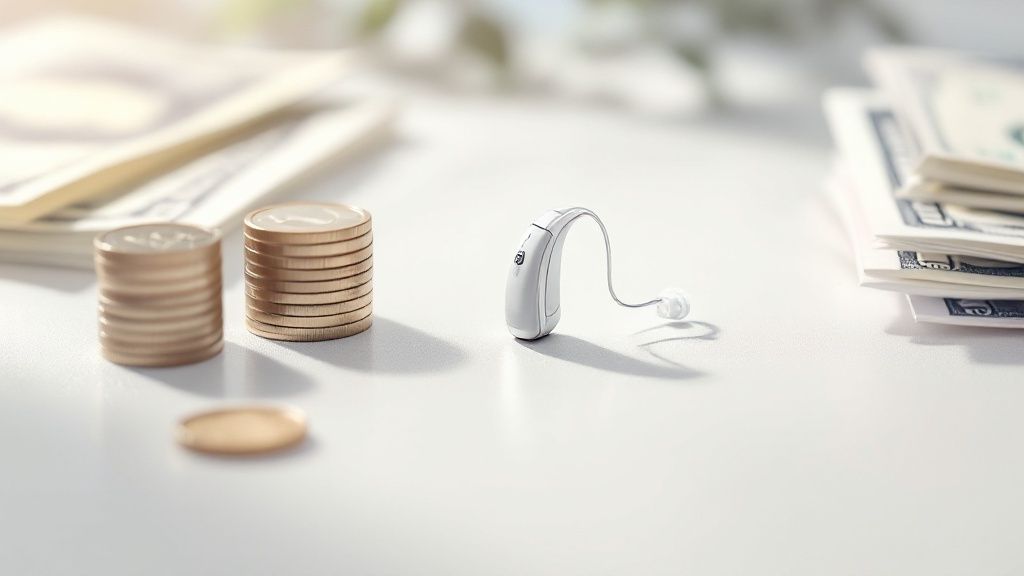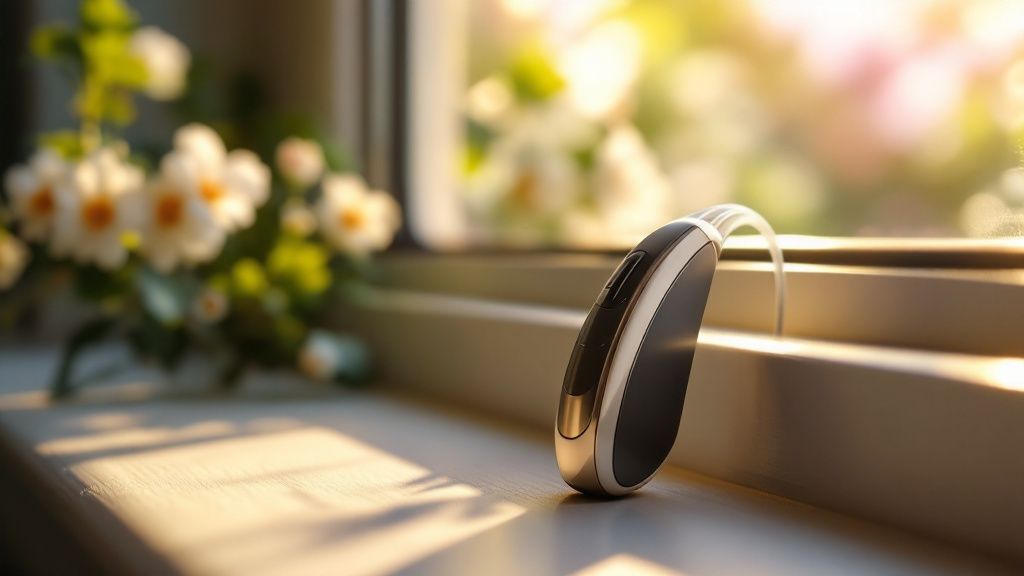Picture this: you’re in a bustling café, leaning in to catch a whispered secret. You hear every word, crisp and clear, while the clatter of plates fades into the background. And the best part? No one even knows you have a little help. That’s the promise of an invisible hearing aid.
But that promise comes with a question that can feel deafening: what’s the real cost? The price you see online, somewhere between $1,000 to over $3,000 per ear, is just the beginning of the story. To truly understand the investment, you have to look deeper—into the technology, the service, and the life-changing value packed into a device smaller than a coffee bean.
This isn’t just about buying a gadget. It’s about reclaiming your world, one sound at a time. So, what are you really paying for? Let's find out.
It Starts With a Price, But Ends With a Connection
Imagine standing at the edge of a conversation, hearing the murmur but missing the meaning. You nod along, feeling the slow drift into isolation. Now, imagine stepping back in. Catching the punchline of a quiet joke, hearing the soft inflection in a loved one’s voice, feeling the confidence to speak up in a meeting.
That transformation is the true value hidden behind the price tag. The cost of an invisible hearing aid isn't just for a piece of technology; it's an investment in connection. It’s the price of rejoining the moments you’ve been missing.
Think of it less as buying a product and more like restoring a vital sense. The cost is really a gateway to reconnecting with the people and experiences you love, completely on your own terms.
Cracking the Code of the Cost Spectrum
So, what creates that wide price range? It's the sophistication of the tiny engine inside. Basic models amplify sound, which is a great start. But the premium devices? They’re like having a sound engineer in your ear, intelligently separating the voice you want to hear from the noise you don't.
Here’s what that looks like in the real world.
A Quick Glance at the Tiers of Technology
| Price Tier | Average Cost Per Unit | What It Feels Like |
|---|---|---|
| Entry-Level | Below $2,000 | The world is turned up. You get foundational amplification, basic noise reduction, often directly from the maker. |
| Mid-Range | $2,001 to $3,000 | Conversations become clearer. Better noise filtering and sound quality bring voices forward. |
| Premium | Above $3,000 | The sound is seamless. AI-powered processing, custom fitting, and Bluetooth create an effortless listening experience. |
As you can see, features like intelligent noise reduction and wireless connectivity are what elevate the price—and the experience. For a more granular look, you can explore more hearing aid market insights.
But the technology is only half the story. To truly understand the numbers, we need to go deeper, into the world of microscopic components that justify the investment. What secrets are hidden inside that tiny shell?
The Ghost in the Machine: What Tech Justifies the Price?
Ever wonder how two objects that look nearly identical can have vastly different prices? With invisible hearing aids, the answer isn’t what you see; it’s the microscopic world of engineering humming just beneath the surface. This is where the real magic—and the cost—comes from.
To understand the price, we need to peer inside and see the years of research and powerful components that create such a seamless experience.
This infographic reveals the hidden forces that shape the final number.

The initial price is a fusion of the device itself and the expert services that bring it to life for you.
The Engine That Powers Your Hearing
Think of it like choosing a car. A reliable sedan gets you there. But a high-performance luxury car transforms the entire journey. The same is true for hearing technology.
-
Entry-Level (The Sedan): These devices make sounds louder. It’s a crucial first step, but they may not be as skilled at picking a single voice out of the din of a crowded room.
-
Premium-Level (The Luxury Car): These are marvels of acoustic engineering. Using powerful processors and even AI, they scan your environment hundreds of times per second. They isolate speech, suppress the clatter of forks, and soften the whistle of the wind, delivering a sound that feels utterly natural.
This leap in processing power is a primary driver of cost. The global hearing aids market, valued at USD 6.70 billion, is exploding precisely because of these technological leaps. They’re what make a higher price point translate into superior performance.
The Artistry of a Perfect, Invisible Fit
But technology is useless if it isn't comfortable. An invisible hearing aid must sit deep within your ear canal—a space as unique to you as your fingerprint.
Creating this perfect fit is part science, part artistry. An expert takes a precise impression of your ear canal to build a custom shell, ensuring the device is not just invisible but also secure and acoustically sealed. It becomes a part of you.
Finally, the price often bundles in professional services. The skill of an audiologist who programs, adjusts, and fine-tunes the device to your unique hearing profile is an invaluable part of the equation. Their guidance ensures the technology serves you perfectly. Now, what if there was a way to get this powerful tech without the traditional overhead?
Making an informed choice begins with understanding what the best invisible hearing aids have to offer in terms of both technology and fit.
A New Path Appears: The Direct-to-Consumer Revolution

For decades, the path to better hearing was a single, expensive road paved with clinical appointments and gatekeepers. But what if you could bypass all of that and find a more direct route? A new path has opened up, and it’s disrupting the entire landscape of hearing health.
The rise of direct-to-consumer (DTC) models is putting powerful technology directly into your hands, making the cost of invisible hearing aids more accessible than ever before. But this new freedom requires a new map.
The Guided Tour vs. The Grand Adventure
Imagine you're planning a trip. One choice is a fully guided tour, where an expert handles every detail. The other is a self-guided adventure, where you chart your own course. Both lead to a beautiful destination, but the journey—and the cost—are worlds apart.
-
The Traditional Clinic Path (The Guided Tour): This is the full-service experience. It includes professional hearing tests, custom moldings, and multiple fitting sessions with an audiologist. This white-glove service is essential for complex hearing loss, but it’s a major driver of the higher price.
-
The Direct-to-Consumer Path (The Grand Adventure): Here, you’re the explorer. Companies sell high-quality, pre-programmed devices directly to you online, cutting out the intermediaries. This dramatically reduces their costs, and they pass the savings on to you. You get affordability and convenience, but you are in control of the setup.
The core trade-off is this: personalized, hands-on service versus significant cost savings and personal empowerment. The right path depends entirely on your needs, your budget, and your comfort with navigating the journey yourself.
Two People, Two Journeys, One Destination
Let's meet two people to see how this plays out.
First, there’s Anna. Her hearing loss is severe with unique challenges that need specialized programming. For her, the traditional path is essential. An audiologist can fine-tune her device to the exact frequencies she struggles with, ensuring she gets the absolute most from the technology. The higher price is a necessary investment in her quality of life.
Now, meet Ben. He has mild-to-moderate hearing loss and just wants to follow conversations better in noisy restaurants. He’s tech-savvy and wants a discreet solution that won't drain his savings. For Ben, a DTC hearing aid is a perfect fit. He orders it online, and it arrives ready to use, pre-programmed for common hearing loss patterns. He saves thousands and reclaims the clarity he was missing.
Neither path is "better"—they simply serve different explorers. For many, the DTC model provides an accessible gateway to hearing support they might otherwise delay for years. It empowers people like Ben to act sooner, preventing years of missed connections. But what if there are ways to make either path more affordable?
Hidden Treasure: Unlocking Financial Relief You Didn't Know You Had
That intimidating sticker price? It’s rarely the final number. Too many people see the initial cost and assume it’s a mountain they have to climb alone. But just below the surface lies a world of financial help that can turn a daunting expense into a manageable molehill.
Think of it like finding hidden treasure on a map—you just have to know where to look. Let's uncover the secrets of insurance, pre-tax accounts, and support programs that most people overlook.
Decoding the Map of Your Insurance Benefits
Your first stop is your insurance policy. This can feel like navigating a maze in the dark, but a little light makes it simple.
Most coverage falls into one of these categories:
- Private Insurance: These employer or self-purchased plans vary wildly. Some offer a specific allowance for hearing aids, often between $500 to $2,500 every few years. Others offer nothing.
- Medicare: This is the big one. Traditional Medicare (Part A and Part B) does not cover hearing aids. It's a frustrating but critical fact. However, some Medicare Advantage (Part C) plans are now bundling in hearing benefits.
- Medicaid: Coverage is decided state by state. Some state programs cover the full or partial cost for adults, while others have strict limits or no coverage at all.
The single most powerful thing you can do is call your insurance provider directly. Ask them, "What are my specific benefits for hearing aids?" Don't assume anything. Get a clear answer straight from the source.
To get a better sense of how Medicare approaches coverage, looking into their policies on other items can be insightful. For example, reviewing [Medicare coverage for medical devices like orthotics](https://mypolicyquote.com/2025/07/19/does-medicare-cover-orthotics/) can offer a window into their evaluation process.
Your Secret Weapon: Pre-Tax Health Accounts
Beyond insurance, you might have access to powerful savings tools that let you use your own pre-tax money—an instant discount on the invisible hearing aids cost.
The two most common are:
- Flexible Spending Accounts (FSAs): Offered by employers, these let you set aside pre-tax dollars specifically for medical expenses, including hearing aids.
- Health Savings Accounts (HSAs): Paired with high-deductible health plans, these also use pre-tax funds, but with a huge advantage: the money rolls over year after year.
Using these accounts is like getting a discount equal to your tax rate. A little planning here can save you hundreds of dollars. For those ready to move forward, our guide on how to buy hearing aids lays out the entire process.
Discovering More Paths to Affordability
Don't stop there. Veterans may be eligible for hearing aids through the Department of Veterans Affairs (VA). Many national and local non-profits also offer financial assistance or provide refurbished devices. A little digging can uncover a program that’s a perfect fit for your situation, bringing the world of sound that much closer.
The Long View: Calculating the True Cost Over a Lifetime

The moment you purchase a hearing aid, a clock starts ticking. That initial price is just the entry ticket. To truly grasp the invisible hearing aids cost, you must look beyond day one and into the next five to seven years of your life. This is the total cost of ownership, and understanding it is the key to turning a purchase into a wise, long-term investment.
The global market for these tiny devices has already soared past USD 4.5 billion, a number climbing fast as technology shrinks and online access grows. This explosion highlights why seeing the full financial picture is so critical. You can explore these trends in this detailed market analysis.
The Hidden Costs That Follow You Home
Think of your hearing aid like a car. You wouldn't buy it and expect to drive forever without gas or oil changes. Your hearing aid is no different. It requires regular care to perform at its best.
These are the running costs that often take people by surprise:
- Replacement Batteries: If your device isn’t rechargeable, you’ll need a steady supply of tiny batteries. It’s a small but consistent expense.
- Wax Guards and Domes: These disposable parts shield the delicate electronics from earwax. You'll change them regularly to keep the sound crisp.
- Post-Warranty Repairs: A good warranty is your safety net, but it eventually ends. An out-of-pocket repair on such a sophisticated device can be costly.
A strong warranty and a clear loss-and-damage policy aren’t just fine print—they are essential financial shields. They protect your investment from the inevitable accidents and wear-and-tear of daily life.
The Incalculable Value of Peace of Mind
What happens if you lose a device smaller than your pinky nail? A good loss-and-damage policy is the difference between a manageable fee and buying a new device all over again.
When you map out the true lifetime cost, you're doing more than crunching numbers. You're planning for a sustainable relationship with your hearing health, ensuring your investment pays dividends in clear conversations for years to come.
And for anyone looking to manage these costs effectively right from the start, our guide to the best budget hearing aids is packed with valuable insights.
Now, with all this knowledge, how do you make the final choice?
The Final Step: From Information to a Confident Decision
You’ve done the research. You’ve navigated the technology, decoded the pricing, and explored the financial paths. You are now at the most important moment: the decision. This isn’t just a summary; it’s your personal launchpad for turning knowledge into action.
It all boils down to a few honest questions. This is where you cut through the noise and discover what truly matters to you, moving from a general understanding of invisible hearing aids cost to knowing what you need to thrive.
What Is Your Personal North Star?
Answering these questions will draw the map for your unique journey. What is non-negotiable for you?
- Discreetness vs. Features: Is total invisibility your absolute priority? Or would you trade a sliver of secrecy for a longer-lasting battery or Bluetooth streaming?
- Your Life’s Soundscape: Where do you live your life? In bustling restaurants and loud offices, or in the quiet of your home and the tranquility of nature? Is streaming music or taking calls directly through your aids essential?
- Your Financial Reality: After exploring insurance and financing, what is a number you feel genuinely good about? Be honest about the initial investment and the ongoing costs.
Once you have these answers, everything changes. You are no longer just a curious researcher; you are an empowered buyer who knows exactly what you’re looking for. You don’t need to be sold—you are ready to choose.
This clarity is your superpower. It allows you to approach any clinic or website with total confidence, knowing you're not just buying technology. You're making a smart, tailored investment in a richer life.
Common Questions About Cost
Your journey toward better hearing often brings up a few final, practical questions. Getting clear, straightforward answers is the last step before you can feel truly confident in your choice. Let's tackle the most common concerns people have about the cost of invisible hearing aids.
Why Do Invisible Hearing Aids Cost More Than Bigger Models?
It comes down to two powerful forces: miniaturization and customization. Imagine engineers cramming a supercomputer—with processors, microphones, and speakers—into a shell that disappears inside your ear.
It’s the difference between building a delicate Swiss watch and a grandfather clock. On top of that, a truly invisible device is custom-molded to the unique curves of your ear canal. This blend of shrunken-down technology and bespoke craftsmanship is what drives the higher price.
Can I Really Find a Good Invisible Hearing Aid for Under $1000?
While getting a custom-fit, audiologist-programmed device for under $1000 is almost unheard of, some direct-to-consumer (DTC) models can fall into this price range for one ear.
These devices are a fantastic entry point for many. They come pre-programmed for the most common types of mild-to-moderate hearing loss. You can get excellent quality for those needs, but you trade the deep personalization that comes from a custom molding and professional fitting.
Does Insurance Ever Cover the Full Cost?
Honestly, full coverage is rare, and policies vary dramatically. Some private insurance plans offer a set allowance, perhaps $500 or $1,000, every few years.
It’s critical to know that traditional Medicare provides no coverage for hearing aids at all. However, some Medicare Advantage (Part C) plans are starting to include hearing benefits. Your best move is to call your insurance provider directly and specifically ask about your “hearing aid benefits” before you start shopping.
Ready to experience crystal-clear sound without the high price tag? At HearDirectClub, we deliver premium, nearly invisible hearing aids directly to you, saving you thousands. Explore our risk-free 100-day trial and rediscover the sounds you love.



Leave a comment
This site is protected by hCaptcha and the hCaptcha Privacy Policy and Terms of Service apply.